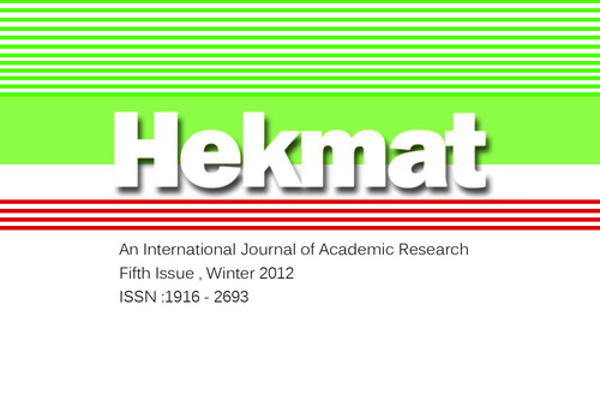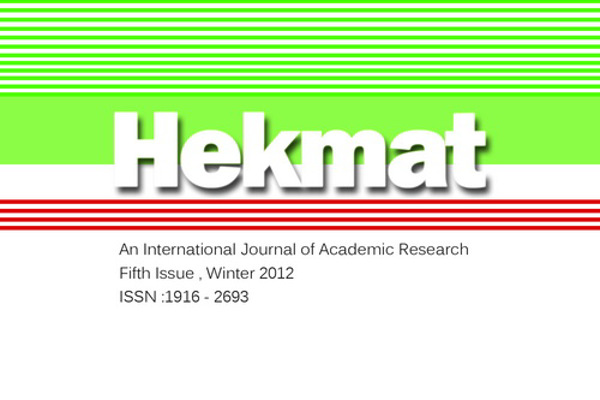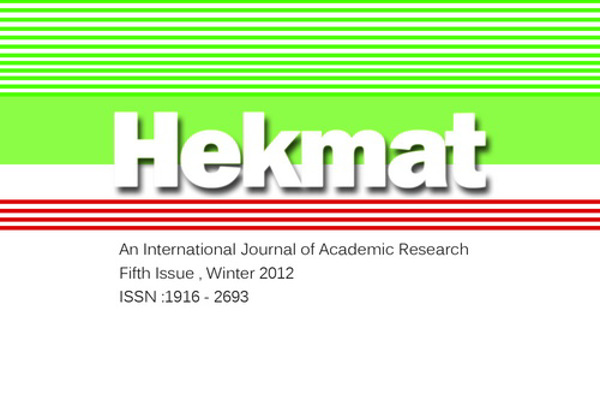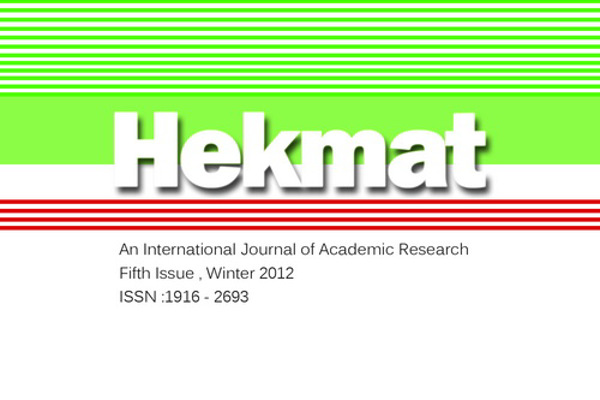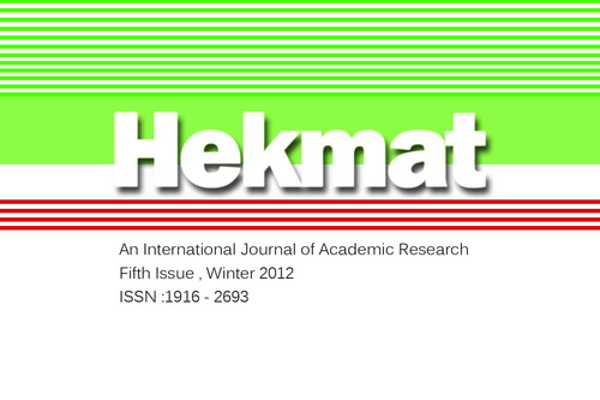Discursive Rationalism in the Methodology of Avicenna Philosophy / By: (Mohammad Mehdi Gorjian) (Masumeh Esma’eeli)
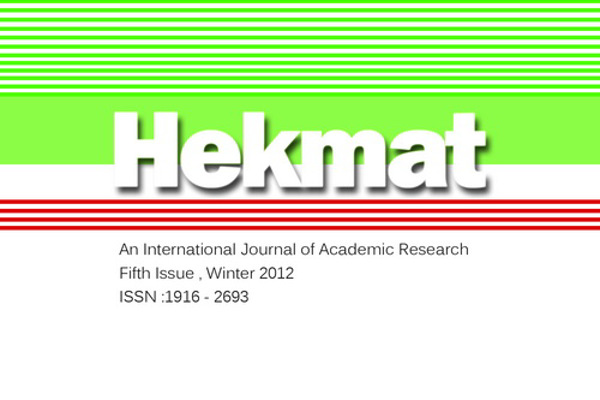
Discursive Rationalism
in the Methodology of Avicenna Philosophy
Mohammad Mehdi Gorjian[1]
Masumeh Esma’eeli[2]
Abstract
In the history of Islamic Philosophy, whereas some Muslim philosophers such as Farabi and Avicenna, following Greek Peripatetics, have merely trusted pure intellectual reasoning in their search for truth, some others, like the followers of the schools of illumination and transcendent theosophy (Hikmat Mota’aliah), have relied also on intuition (Shohoud) and illumination (Ishraq) as independent and accountable methods of discovery on a par with intellect.
According to Avicennian discursive rationalism (Aqlaniiate Bahsi), logic plays an important role as the law of thought, and demonstration is considered the best way of acquiring knowledge and certainty. Axioms form a crucial foundation in discursive rationalism. Divine intellect and conjecture are among deep illuminationist concepts which Avicenna tackles within the sphere of discursive rationalism.
However, in spite of all these elements, intellectual reasoning is not a perfect method for discovering the truth since Avicennian intellect is not all by itself able to discover all truths and its findings are not of sufficient degrees of accountability when it comes to deep layers of knowledge. In order for Avicenna intellectual reasoning to be able to discover the absolutely accountable truth of the world of existence, it needs to incorporate intuition and mystical understanding of the truth as well.
Key Words: rationalism, discursive rationalism, conjecture, Divine intellect (Aqle Qudsi), methodology, Avicenna
The History of Rationalistic Method
Turning the pages of the history of Islamic thought, we come across four different philosophical trends, each of which has its own distinct method of thinking and truth seeking.
Trend I. The way of thinking that was adopted by Zakariya Razi, Abu Rayhan Biruni, and Kharazmi. These thinkers rejected pure reason as a way of discovering the truth, and used induction instead, viewing Aristotelian logic as insufficient for that purpose.
Trend II. The way of thinking that was adopted by Farabi and Avicenna. They considered themselves as followers of Aristotle’s school.
Trend III. The way of thinking that was adopted by illuminationist philosophers. This trend grew in reaction to Aristotle’s school of thought[3], although it was itself based on some kind of rationalistic reasoning.
Trend IV. This was the point where the above-mentioned trends intersected, and as a result, there appeared a school in which many of the prima facie contraries between philosophy and mysticism, philosophy and kalam, and between peripatetic and illuminative philosophies were resolved. This school was called transcendent theosophy.[4]
Of course, there have been different classifications of trends in the history of Islamic philosophy. Peripateticism, illuminationist wisdom, and transcendent theosophy shape the main philosophical trends in the history of Islamic philosophy. The School of Separation (Maktabe Tafkik), is also considered an important school in some classifications.
In peripateticist methodology, empirical knowledge (Ilm Hosuli) and rational reasoning are regarded as the way of reaching the truth, and peripateticist reasonings are based on logic and proof. But, in illuminationist methodology, in addition to logic and proof, intuition is also regarded as a way of reaching the truth. The peripatetic school attaches no significance to intuition; it considers the logical methodology to be sufficient. In contrast, the illuminative school takes intuition as necessary and holds that without spiritual purification and refining (Tahziib), logical principles cannot lead us to the reality. In this school, a sage is taken to be someone who involves in both rationalistic arguments and being devout and pious (Ta’alloh), that is, someone who explicates rationalistic reasoning along with intuition and vision.[5]
Transcendent theosophy, which appeared after these two schools, was a combination of intuition, illumination, and rationalistic reasoning. In this school, logical proofs are provided for illuminationist doctrines. In fact, while peripatetic philosophy did not satisfy the proponents of intuition and mysticism, and while illuminative philosophy addressed only those interested in spiritual purification and refining, transcendent theosophy discussed both peripatetic and illuminative philosophies and provided rationalistic foundations for illuminationist doctrines[6]; it offered rationalistic reasoning as verification of intuition and vision.
Intellectual Methods
Argumentative-Discursive Method
The proponents of pure argumentative method can be regarded as followers of Aristotle. In the history of Islamic philosophy, this method was practiced by different philosophers from Yaqub Ibn Ishaq Kenedi to Avicenna. This kind of philosophizing is based totally on rationalistic reasoning. This method had many proponents such as Abu Ishaq Kenedi (261), Abu Nasre Farabi (331), Abu Hasan Ameri (381), Avicenna (321), Abu Barakat Baqdadi (547), and Averse (597). Avicenna was one of the most famous representatives of this school of philosophy in the Islamic world. Pure rationalistic method is a characteristic of the peripatetic school. The peripatetic school is methodologically Aristotelian in character and is based on logic.
From a peripateticism point of view, the way intellect can discover the truth is through theoretical reasoning. Pure rationalistic method is a kind of argumentative method. In other words, it is a transitive method, because in this kind of philosophizing, the peripatetic philosopher acquires the unknown by arranging the known next to each other, and so their mind moves from what they know to what they do not. In the peripatetic rationalistic methodology, obtaining knowledge is possible only through this theoretical transition. Thus, the philosopher acquires the truth by raising an argument, and their argument is based ultimately on the axioms (Avaliyyat). Hence, there is no room for intuition and illumination in this school of philosophy.
Intuitional-Discursive Method
In this method, whose founder was Sheikh al Ishraq, acquiring the truth is based on mystical intuition and vision. Thus, contrary to peripatetic philosophy, spiritual journey is prior to intellectual journey. In his will, Sheikh Ishraq says that a prerequisite for understanding his book Illuminative Theosophy (Hikmat Ul Ishraq) is spiritual purification.[7] He considers his approach illuminationist since it is indeed the presence and irradiation of the Divine Light to the soul.[8] Hence, vision and argument together form the theme of illuminative philosophy. In the first volume of his Al-Talvihat, Sohravardi says, “do not imitate me or anyone else for the criterion to recognize the truth is argument, that’s all.[9]” Evidently, he relies on argument as well as vision and this is what differentiates illuminative philosophy from mysticism. In his introduction to Illuminative Theosophy, he says, “the most important seekers of divine knowledge are those who seek both spiritual refining and argumentative-discursive wisdom…this book of mine is for those who seek both intuitive and discursive wisdom.[10]”
Intuitional-Discursive Method in Transcendent Theosophy
Although the term “transcendent theosophy” was first used by Avicenna in his Isharat, his philosophy was never called so. Rather, the title transcendent theosophy went to Mulla Sadra’s philosophy. In this school, a lot of the disagreements between illuminative and rational philosophies were discussed and settled down. Mulla Sadra’s school is based on both intuition and reasoning. Like illuminative school, Mulla Sadra’s school integrates vision and reasoning. But compared to illuminative philosophy, the attempts made at the demonstrative reasoning of his philosophical ideas are greater and more tangible.
Transcendent theosophy consists of peripateticism, illuminative philosophy, neo-Platonic philosophy, Stoic philosophy, ancient Iran’s philosophy, mystical teachings, the Holy Quran, and traditions. About his philosophy, Mulla Sadra says, “it consists of theological knowledge flourished in discursive philosophy and fortified by revelations of truth narrated in pedagogic expositions.[11]”
About Mulla Sadra’s school, Professor Henry Corbin writes, “if we think of him as an Avicenna researcher, we have to add that he is practically an illuminative practitioner, and at the same time, he is full of Ibn Arabi’s ideas.[12]” Of his own philosophical school, Mulla Sadra says “this philosophy is not a set of mere theological arguments or blemished discursive philosophical problems; nor is it a set of Sufi imaginations.[13]”
Sadra’ian method is to equip Sufism with intellectual reasoning and argument. In his philosophy, Mulla Sadra relied on both intellectual reasoning and intuition. He believed that the truths that are revealed by intuition can be demonstrated by intellectual reasoning.
The Status of Determinate Intellect in Philosophical Issues
In the history of Islamic philosophy, various schools have appeared. Each of these schools lived for some while without a rival, but after a while, waned with the rising of other schools, or coexisted with them. One of the things that distinguishes different philosophical schools and makes a specific school stand out is the method and principals of the school. In each of these schools, intellect is used in a different way. Given the general principles that they accept, the philosopher determines the direction that the mind should go. Some philosophers open the eyes of intellect to all methods of obtaining knowledge. In some others, however, philosophical intellect gets stuck in and limited to one specific procedure. For example, some philosophers only use intellectual reasoning to reveal the truth while some others use both intellectual reasoning and mystical intuition to unveil it.[14]
Peripatetic philosophy tries to reach reality through pure reasoning. It limits itself to intellectual demonstrations. So it is unable to analyze some religious doctrines or to reveal some deeper truths. For instance, it cannot reach the truth in issues such as the nature of resurrection of the body. However, transcendent and illuminative philosophies remedied this defect and used both intellectual reasoning and mystical intuition to discover reality.
Avicenna adopted the pure rationalistic method. But he recognized the importance of vision and intuition in his later mystical symbolic treatises, and in the last three parts of his Isharat. In these writings, he recognized as a genuine method what he previously regarded as poetry and rhetoric.
In the tenth part of his Isharat, he points out that this method is hidden to everybody except to those firmly-rooted in transcendent theosophy.[15] Toward the end of his life, Avicenna tried to exploit a combinatory method of reasoning and intuition. But death did not give him the chance to do so. Thus, his philosophy is dominated by pure discursive rationalism. Sometimes, he has even literally acknowledged that the only way to discover the truth is intuitional vision.[16] After Avicenna, Sheikh al Ishraq and, more effectively, Mulla Sadra integrated the two methods to discover the truth of world.
Peripateticism and the Intellectual Method
Islamic peripatetic philosophy, with ideas taken from Aristotelian philosophy, neo-Platonism, and religion, made its way to the Muslim world. Farabi explicated most of the problems in Aristotelian philosophy, and Avicenna tried to explicate Farabi’s brief remarks. In fact, Avicenna borrowed most of his discussions from Farabi. It is a matter of controversy whether Avicenna has generated a separate philosophy. He borrowed most of his philosophical doctrines from what Farabi had said, such that many of his delicate and precise discussions can be found in Farabi’s works. Hence, some people consider Avicenna as a clever follower of Farabi. However, there are some original discussions in Avicenna’s philosophy, which cannot be found in Farabi’s philosophy, and this puts us into skepticism about Avicenna being a mere follower of Farabi. In any event, Avicenna has been called the pioneer of peripateticism because his philosophical books are regarded as the best sources of peripatetic philosophy, and because all peripatetic ideas are formulated, explained, and defended in the best way in his books.
The Greek peripatetic philosophy was not the only school to influence Avicenna’s philosophy; there are other sources such as Islamic doctrines, Islamic mysticism, and neo-Platonic philosophy that have influenced his philosophy.
Although Avicenna was a peripatetic philosopher, some of his views differ from those of Aristotle’s. In some cases, he distances himself from peripateticism and takes the other routes to the truth.[17] However, since most of his books are commentaries on peripatetic philosophy, he is generally regarded as a discursive philosopher who was inclined towards illuminative philosophy towards the end of his life.
Avicenna’s Philosophy
Avicenna’s philosophical thought had two different phases. In his former phase, Avicenna was a pure peripatetic and rationalistic philosopher who discussed all problems in the peripateticist framework. In this phase, mysticism was demoted to the level of poetry. However, in his latter phase, Avicenna was inclined towards illuminative thoughts and mysticism. In this phase, he tried to found, with the help of neo-Platonic, mystical, and Islamic thoughts, a new philosophical system. He named this philosophy as Oriental Wisdom (Hikmat Mashriqi). For many years, Muslim philosophers have been discussing the meaning of “Oriental Wisdom.” Avicenna says that he has, besides Shifa and Lawahiq, another book in which he has discussed philosophy as it should be. In this book, he has frankly opposed peripateticism from many points. In his view, whoever seeks unambiguous truth should refer to this book.[18] Of course, the only thing that has remained from Oriental Wisdom is the logic part. Tracks of the new philosophy of Avicenna can be traced in his symbolic and mystical treatises such as Salaman wa Absal, Risalat al Tair, Qasidat Ayniyyah, Hayy Ibn Yaqdhan, and the last three parts of his Isharat. The fundamental principles of Avicenna’s thought are peripateticist Aristotlian combined with some apparent neo-platonic ideas. The method of discussion in these treatises is argumentative and totally intellectual, and even the spiritual guide in Hayy Ibn Yaqdhan is intellect.
Avicenna and the Peripatetic School
Towards the end of his life, Avicenna decided to diverge from peripateticism -i.e. pure discursive philosophy- and to get close to mysticism and intuitional method. Hence, in his introduction to Eastern Logic (Mantiq al Mashreqain), he talks about founding a kind of illuminative philosophy which is distant from peripateticist principles. As he explains, it becomes clear that Oriental Wisdom is not a pure discursive philosophy, and its goal is not merely providing logical arguments for the explanation of philosophical ideas; rather, it is a kind of wisdom whose goal is to save mankind from the imperfect and finite world and guide him towards non-material lights. Such a wisdom is non-Greek and non-peripateticist.
Discursive-Rationalistic Elements in Avicenna’s Philosophy
As the firmest and most articulate peripateticist philosophical system after Aristotle, Avicenna’s philosophy is a rationalistic system. In Avicenna’s view, the only way of reaching the truth is through argument. Thus, logic and argument are among the important elements of peripateticist discursive philosophy. In Avicenna’s philosophy, the importance of reasoning and argument is to the extent that there remains no room for intuition and illumination in it, and truth is taken to be discovered by argument. Of course, in his latter phase of philosophy, intuition was regarded to be an important way of unveiling the truth. The discursive-rationalistic elements in Avicenna’s philosophy are as follows.
Aristotelianism
One of the most important discursive-rationalistic elements in Avicenna’s philosophy is Aristotelianism. This kind of sacrosanctity of a philosopher and his/her ideas have been experienced in different periods of the history of Muslim, Greek, or western philosophies. For instance, in the Shiite jurisprudence, Sheikh Tousi’s ideas were regarded as sacred and unable to be criticized, and until a century after him, no jurisprudential book was written; any jurisprudential attempt or hypothesizing was considered undue insolence or disrespect towards Sheikh Tousi. This trend went on until a century later when Ibn Edris Helli broke this taboo. The same thing happened in the Avicennian period regarding Aristotle and Aristotlian thought as taboo, such that in his introduction to his book The Healing, Avicenna blames his contemporaries of being fanatic periraticiants.[19] Avicenna’s adherence to Aristotlianism led him to neglect intuition and illumination, although he tried, to some extent, to use them in his later short treatises.
Logic in Avicenna’s Philosophy
Logic is one of the important elements of discursive rationalism. It is the foundation of peripatetic philosophy. Muslim logicians borrowed their logic not only from Aristotle but also from stoics, Porphyries, Galain, and others. In the first part of his The Healing, Avicenna points out that the goal of logic is to enable the mind to discover the unknown from the known.[20] Avicenna thinks of logic as something beyond linguistics and linguistic rules.[21] In collecting the logical discussions and arguments, Avicenna used his own style, and opposing the approach of Baghdad School, he wrote a book entitled Logic of the East (Mantiq al Mashriqayn) which was different from that of Farabi’s.
In his The Healing, Avicenna established all peripateticist logical and philosophical elements and analyzed the peripateticist discursive philosophy. In his logic, Avicenna was a follower of Farabi; Farabi was, in fact, the founder of logic in Islamic philosophy. Logic was very important to Avicenna. In his view, the science of logic is indeed the scale for other sciences while other sciences discuss profit and loss. Avicenna believed one can reach certainty and truth with the help of logic. Any stream of knowledge that cannot act as a scale is therefore not capable of bringing certainty, and it should not even be regarded as knowledge. Thus, to reach certainty, one must learn logic.[22] Avicenna was a philosopher, but considered logic as the gateway to philosophy. He even begins his illuminative philosophy with a discussion of logic. In his view, logic is as important for illuminative philosophy as it is for peripatetic philosophy. So, he held that even illuminative philosophy must begin with logic; he believed that thought is ordered only with logic and the only way of reaching the truth and certainty is through logic. In Avicenna’s view, logic includes a wide range of problems; the problem of deduction is only one part of this science. So, the significance of its other problems should not be overwhelmed by the importance of the problem of deduction. However, Avicenna is aware of the limits of this science. Hence, he himself tells us that logic cannot reveal the truth by itself. Rather, it helps us use the knowledge we have in the best possible way.[23] Logic does not give us the axioms of perception; these principles are obtained from outside logic. Logic only teaches us how to use these principles in the best way. So, it contains neither truth nor falsehood; the truth of propositions is discovered by perception and empirical observation.
Although logic has its own limitations, Avicenna considers it so important and treats the logicians respectfully and challenges his audience asking if there is anyone who can add anything to the logic that Aristotle founded 1330 years earlier.[24] Nevertheless, he sometimes acknowledges the limitation of logic. For instance, after explaining the principles, rules, and definitions, he points out the difficulty of providing real definitions and tells that most of the provided definitions of things are not genuine.
Avicenna’s The Healing, which is a commentary on Aristotelian logic and philosophy, is regarded as a grand encyclopedia of peripatetic philosophy. Although his major attempt was to explain Aristotelian logic, Avicenna had also some innovations. For example, in his Isharat, after discussing the kinds of deduction, Avicenna opposes most logicians’ conjunctive syllogism and raises a new hypothesis in this regard.[25] It can be known from these discussions that Avicenna was not merely a commentator of Aristotle’s works. Rather, he had contributions to Aristotelian logic and philosophy.
The Significance of Axioms as Foundations for Arguments
Argumentation and reasoning enjoy a high status in discursive philosophy. In Avicenna’s view, reasoning is the way to the truth and certainty[26] since one can, by reasoning, discover the existence of things. This reasoning can take two different shapes. On the one hand, one can argue from the effects of a thing to its existence. On the other hand, one can argue from the existence of a thing to the existence of its effects. In discursive philosophy, arguments have the highest place.[27] Thus, the premises of arguments must be sufficiently firm and rich. Since the premises are necessary for the conclusion, they must be necessarily true themselves. Avicenna holds that since the truth of the conclusion in an argument comes from the truth of its premises, our knowledge of the premises must be prior to, and firmer than, our knowledge of the conclusion.[28] He believes that the primary demonstrative syllogisms possess premises whose truth is supported by perception or stronger arguments or whose truth is self-evident.[29]
In contrast to dialectical syllogisms, demonstrative syllogisms are firmer, for the premises of the former syllogisms are the generally-accepted (Mashhour) whereas the premises of the demonstrative syllogisms are constituted of axioms. This guarantees the perfection and soundness of demonstrative syllogism.
Demonstrative syllogisms are of different kinds. They are either simple or compound. The premises on compound demonstrative syllogisms need other demonstrative syllogisms to be justified. This process continues until we reach primary demonstrative syllogism (Qiyas Awaliyah), which are composed of the self evident. The self-evident are of two kinds: the primary self-evident (Badihyyat Awali) and the secondary self-evident (Badihyyat Thanawi). The primary self-evident are first principles. The secondary self-evident are of five kinds. Thus, all demonstrative syllogisms must return to first principles in which case the truth of the premises are guaranteed.[30]
In discursive philosophy, everything proceeds step by step. First, the axioms are proved. Then the secondary self-evident are proved. And the compound syllogisms must return to simple syllogisms. Thus, to reach the truth, one must take all these steps. Of course, being self-evident does not always entail that one asserts its truth as soon as he/she entertains[31] it since the perceiver sometimes suffers from deficiencies, and so he/she cannot immediately realize its truth.
The Status of Conjecture in Discursive Philosophy
Avicenna brings up the problem of conjecture as an introduction to his analysis of inspiration and divine revelation. He explains the difference between prophets and ordinary people in terms of the difference they demonstrate in this faculty. He regards the faculty of conjecture as a helper of the sacred intellect.[32]
According to Avicenna, mental education is conducted in three different ways: through thinking, conjecture, and understanding. The mind is educated through thinking when it searches in its stock of knowledge to find the correct middle term (Hadde Vasat), and to use it to solve the problem in question. The mind is educated through conjecture when it finds the correct middle term without searching in its stock of knowledge; in this way of mental education, the seeker obtains the middle term by conjecture. And finally, the mind is educated through understanding when it is taught by a knowledgeable teacher.[33] In Avicenna’s view, the highest kind of knowledge is knowledge by conjecture.[34]
Avicenna divides man’s theoretical intellect into four different levels. After explaining these levels, he emphasizes on the level that is not common among ordinary people, but rather is bestowed upon God’s saints. At the level of intellectus in habitu (Aqle Be AlMalake), man obtains the self-evident concepts and beliefs. In learning them, man does not need thinking or teacher. Rather, the mind possesses this level by instinct. After this level, the rational soul (Nafse Nateqe) is ready to learn more. It is at this stage that Avicenna brings us the concept of conjecture, and attributes obtaining of other concepts and beliefs to the work of thinking and conjecture.[35] He says that to obtain the intelligible, which are not known to man by instinct, he/she needs to know the correct middle term. The middle term is obtained either by thinking or by conjecture. People are different in their power to learn these middle terms:[36] some of them obtain them after some moments of thinking and some need much more time to obtain them. There are some who do not need thinking to obtain them; they obtain them suddenly by conjecture. These latter people are inspired by active intellect (Aqle Fa’al); the ideas in the active intellect are instantaneously bestowed upon their minds. Avicenna appeals to this level of intellect to prove the existence of sacred intellect (Aqle Qudsi). He holds that whoever enjoys this level of intellect possesses a sacred intellect. In his view, this level of intellect is possessed only by prophets; only they use the sacred intellect to know the unknown. In praising this level of intellect, Avicenna says that “this faculty is a portion of prophecy; it is, rather, the highest faculty of prophecy. This faculty should be named the ‘sacred faculty’. It is the highest level of human soul.[37]” Thus, it can be claimed that prophets, who are at this level of rationality, are above and beyond all philosophers since a philosopher is someone who tries, by thinking and raising arguments, to obtain the philosophical unknown. Whereas, obtaining the unknown by conjecture involves a rational faculty higher than the faculty of thinking. Prophets possess the highest level of conjecture faculty and the sacred intellect. So, the intelligible are formed in their souls without thinking. Hence, their doctrines are infallibly true. Thus, it can be inferred that the intellect which is open to the Sacred Law (Shari’at) and mysticism is higher, by far, than the pure discursive intellect, and that the teachings of prophets are above all others’ teachings.
Incorporating Conjecture within Intellectual Reasoning
The operation of thinking, which is acquiring the unknown by investigating the known, enjoys an important status in Avicenna’s discursive philosophy. However, Avicenna accepted the doctrine of conjecture and tried to find a place for it in his philosophy. By finding a place for conjecture in the operation of thinking, Avicenna tried to make room for mystical intuition and revelation in his philosophy. He could have elaborated on his doctrine of conjecture more and thus he could have explained its importance further. In conjecture, the passing of the mind from the known to the unknown occurs instantaneously, and this is, in fact, the radiation of Active Intellect (Aqle Fa’al) on the human soul. Avicenna puts conjecture on the highest level and higher than the level of ordinary thinking, which is moving from the unknown to the known.
By accepting the doctrine of Sacred Intellect (aqle qodsi), Avicenna puts prophets on the highest order of knowledge. So he found a place, in his philosophy, for mysticism and intuition. This was elaborated on in Illuminative philosophy and reached its highest point in transcendent theosophy.
A Critique of Discursive Rationalism
Because of his specific way of thinking, Avicenna was influenced by some specific aspects of Platonic philosophy. He adopted those Platonic elements that were in accordance with his own rationalism, and mixed Platonic philosophical rules with formal logic. But he did not attend to the illuminationist dimensions of Platonic philosophy. In later years, there appeared such great philosophers as Suhravardi and Mulla Sadra who combined illuminationist methods with rational discursive ones, and so created philosophical systems which incorporated intellect, intuition, and mysticism. Truths are more accessible to illuminationist method than to peripateticist one. Suhravardi says, “Before writing Illuminative Wisdom, I had written books on peripatetic style. In them, I explained peripatetic philosophical rules. But Illuminative Wisdom has a different style and follows a method closer than the method of peripateticism. In this method, subjects are not known through thought, but rather, through asceticism and spiritual struggle. Then, arguments are provided for them.[38]” It is obvious that a pure rationalistic philosophy is weaker than a philosophy that consists of purification of soul, visional knowledge, intellectual reasoning, and appeal to Quranic verses and traditions. Sheikh Ishraq regards Peripatetic philosophical system, to which he refers as “discursive wisdom” unable to reach the truths of the world. In his introduction to Illuminative Wisdom, Suhravardi says, “Who adopts the discursive method in philosophy must follow the Peripatetic way, which is well-written. We have nothing to tell him about illuminative rules.[39]” As a critic of peripateticism, Suhravardi blames followers of Aristotle and explicitly announces that true heirs of wisdom are those illuminative philosophers who combine rationalistic reasoning with spiritual and esoteric experiences.
One of the defects of discursive rationalism is that the rationalist philosopher is not able to explain God’s immediate knowledge of the world.[40] According to Avicenna, God’s self-knowledge is immediate in the sense that He knows Himself without any mediation of either a cause or image. So His knowledge is direct and by essence. But as to the Divine knowledge of the world, he holds that His knowledge is free of the mediation of a cause but remains skeptical about the mediation of images. The reason is that he interprets Divine knowledge of the world in terms of His beholding the world via images. Had he developed an illumination taste as the expositor of his works Khajeh Nasir Tousi did, he could envisage Divine Knowledge of the world in terms of presence whereby He knows because everything is present before Him.[41] In this manner, Avicenna would have rendered the notion of images redundant in explanation of God’s knowledge of the world.
To explain the intellects’ knowledge of their causes, Avicenna appealed to the notion of illumination. If he had appealed to this notion in the problem of God’s knowledge or in the problem of bodily resurrection, he could have solved these problems too. Although Avicenna emphasizes on the immortality of individual souls, he cannot make sense of the resurrection of the body. He accepts the resurrection of the body only because the truthful informer (i.e. the prophet) said that it is true.[42] In the problem of resurrection, Avicenna held that immaterial beings are immortal. But he believed that the material beings are mortal. In justifying his beliefs, he said that whatever does not involve matter cannot perish; that which extinct is matter and material beings. Confronting the problem of the resurrection of the body, he said that “this problem is one of the problems to which intellect has no way.[43]” Here, he talks about the defect of the intellect. In his treatise Azhaviiah, he severely criticized the proponents of the resurrection of the body. Avicenna saw the intellect’s way to this problem closed. So, he appealed to revelation to justify it. He could not demonstrate the resurrection of the body with reasoning because he relied on the peripatetic intellect. But, Mulla Sadra could intellectually prove the resurrection of the body with the help of his theory of movement of substances (Harkate Jowhari). He could prove it because he opened his mind to illuminative as well as discursive methods.
Conclusion
Different intellectual methods consist of different elements. These elements make the methods different. Aristotelianism and appealing to conceptual intellect is one of the most important elements of discursive rationalism. Relying on logic and rationalistic argument is another element of discursive rationalism. Thus, discursive philosophy is based on logic and demonstrative syllogism; this method attaches no significance to intuition and vision and it is not sufficient for revealing the truth for it sometimes needs to appeal to intuition and vision to unveil some deeper truths.
[1]. Baqir al Ulum University.
[2]. Baqir al Ulum University alumna.
[3]. Sajjadi, Sayyed Jafar, A Lexicon of Philosophical and Theological Sciences, Amirkabir Publication, Tehran, 1978.
[4]. Khamene’ei, Sayyed Mohammad, The Evolution of Theosophy in Iran and the World, p 285, Islamic Theosophy Publication, 2001.
[5]. Sohravardi, Hikmat al Ishraq, Shahreozi’s Annexes, p 31.
[6]. Ibid, p 33.
[7]. Sohravardi, Al-Mashari’ wal Mutarahat, first collection, p 494.
[8]. Ebrahimi Donyaee, Gholamhossein, The Reach of Intellect and Intuition in Sohravardi’s Philosophy, p 24, Hekmat Publication, 1997.
[9]. Sohravardi, Hikmat al Ishraq, Shahreozi’s Commentaries, p 11 and Sajjadi, Sayyed Jafar, Sohravardi and Hikmat al Ishraq, p 9, Philosophy, Tehran, 1984.
[10]. Ibid.
[11]. Mulla Sadra, Asfar, Introduction, p 10.
[12]. Henry Corbin, Al Masha’ir, introduction, p 33.
[13]. Ibid, p 3.
[14]. The lessons by professor Yazdanpanah, transcendent philosophy, lessons 9 & 10.
[15]. Khajeh Nasir al Din Toosi, A Commentary on al Isharat wal Tanbihat, vol. 3, p 399.
[16]. Ibid, vol. 3, p 390.
[17]. The Great Islamic Encyclopedia, page 103.
[18]. Avicenna, Shifa, vol. 1, p 10, Ayatollah Najafi’s Library, Qom, 1983.
[19]. Avicenna, Al Mantiq al Mashreqiyyn, p 3, Tabrizi Publication, Tehran.
[20]. Avicenna, Al Shifa, al Madkhal lil Mantiq al Shifa, p 17.
[21]. Ibid, pp 21-22.
[22]. Avicenna, Al Shifa, al Madkhal lil Mantiq al Shifa, pp 12 & 16.
[23]. Ibid.
[24]. Avicenna, Al Shifa, al Safsatah, pp 110-112.
[25]. Khajeh Nasir al Din Toosi, A Commentary on al Isharat wal Tanbihat, vol. 1, p 235.
[26]. Avicenna, Al Shifa, al Mantiq, p 54 of dhwil Qurba, 1428 Lunar Hegira.
[27]. Ibid, p 117.
[28]. Mesbah, Mohammad Taghi, A Commentary on al Shifa, pp 303-304, Imam Khomeini Institute, 2005.
[29]. Ibid, p 61.
[30]. Ibid, p 61.
[31]. Ibid, p 330.
[32]. Ibid, p 363.
[33]. Khajeh Nasir al Din Toosi, A Commentary on al Isharat wal Tanbihat, vol. 1, p 358.
[34]. Ibid.
[35]. Khajeh Nasir al Din Toosi, A Commentary on al Isharat wal Tanbihat, vol. 2, p 359.
[36]. Al Isharat wal Tanbihat, p 194.
[37]. Khajeh Nasir al Din Toosi, A Commentary on al Isharat wal Tanbihat, vol. 2, p 359.
[38]. Sohravardi, Shahab al Din, Hikmat al Ishraq, introduction, p 3.
[39]. Sohravardi, Shahab al Din, Hikmat al Ishraq, introduction, p 2.
[40]. Beheshti, Ahmad, A Commentary on Al Isharat wal Tanbihat, p 243, Boostane Ketab Publication, Qom, 2006.
[41]. Ibid.
[42]. Aviccena, Ilahiyyat Shifa, p 62.
[43]. Ibid.


